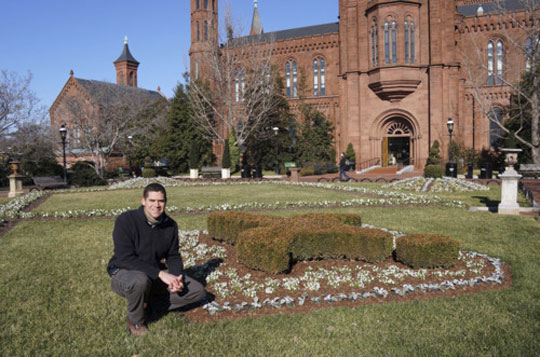Don’t forget to keep turning your compost
Many visitors are surprised to learn that the Smithsonian includes a number of outdoor gardens. All have been designed to complement the museums they border and to enhance the overall museum experience of learning, appreciation and enjoyment. Although winter may the time for gardens to rest up for spring, gardeners are busy year round. Brett McNish, Smithsonian Gardens supervisory horticulturist, offers up some suggestions for winter gardening!
Q: What do you do here at the Smithsonian?
A: I’m Brett McNish, Smithsonian Gardens supervisory horticulturist. I oversee the work of nine talented Smithsonian Gardens staff who manage and maintain the gardens and grounds around four Smithsonian museums—the National Museum of the American Indian, the National Museum of Air and Space, the Hirshhorn Museum and Sculpture Garden and the National Museum of American History (NMAH).
Q: What kind of bulbs did you plant at the Smithsonian last fall for spring bloom?
A: We’ve been working on an awesome spring bulb-enhancement project in the gardens at NASM. From early October to mid-November, the NASM Smithsonian Gardens staff planted 15,000 new bulbs in the terraced gardens surrounding the museum. Many of these bulbs were selected for beauty and design continuity, as well as for their unique cultivar names that reflect the Air and Space theme of the museum. This March through May, visitors will see bulbs blooming with names like “Tang” Tulips, “Gigantic Star” and “Jetfire” Daffodils, and “Globemaster” onions (Allium gigantium). Another bulb in the project is Siberian squill (Scilla siberica), which was selected for its ability to naturalize over time and eventually create a light blue spring blanket under the willow oaks on the west side of the museum. Visitors should keep an eye on the gardens at NASM this spring as they will have a massive color punch—with more to come in 2013 with additional “big wow” enhancements planned! It’s also a great idea for visitors to walk through all Smithsonian Gardens throughout the spring and summer and chat with our horticulturists to collect ideas on what to do in their own yards.
Q: What’s happening underground to plants during the winter?
A: In the fall, environmental factors such as shortened day length and lower temperatures cause a physiological response in plants. We see trees and shrubs shedding leaves and perennials “dying back” to the ground. What we don’t see underground is really fascinating—most plants prepare for the long winter by concentrating salts in root structures, forcing water from the plants’ cells. This is a brilliant biological phenomenon. If water is left in cells and freezes, the razor-sharp edges of the water crystals rupture the cell walls and destroy the plant.
Q: What is your No. 1 tip for taking care of your winter garden?
A: Winter is a great time to think about the next growing season. Get your seeds ordered by January, bareroot roses ordered by February and I know it’s cold outside, but keep flipping that compost pile!
Q: What’s your favorite winter plant and why?
A: My favorite winter plant is Taxodium distichum, or Swamp Cypress. We have many around the large pond at NMAI, and we just planted a row in the recesses in the north terrace of NMAH.Taxodiums are a deciduous evergreen, which means they drop their needles in the winter. With the needles gone, you can clearly see the fine-textured brown sugar bark and beautiful branching habit as very architectural and skeletal in form. There is one in particular that I have been admiring for many years in a central Pennsylvania town called Selinsgrove. It’s on Route 15 next to an auto glass shop, and it’s one of the finest Swamp Cypress specimens that I’ve ever seen. Someone else must appreciate the tree as much as I do because there is a Google street view marker right in front of it!
(This post originally appeared on the Smithsonian’s tumblr.)
Posted: 25 January 2012
- Categories:





